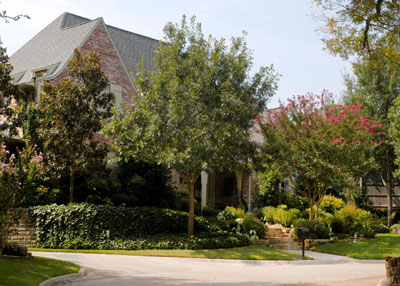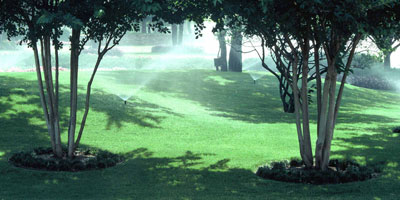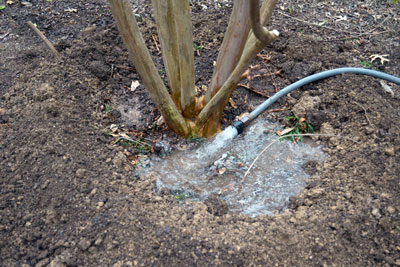Watering Trees in Summer
It’s been a rough several weeks with vertigo. (Under doctor’s care and a couple of Epley maneuvers, it’s getting better). I opted to rerun a very important story for you here. Your trees will be glad you have read it.

Trees pull hundreds of gallons of water out of the soil every day in the summer. Replenish it regularly to keep them healthy and vigorous.
Unless you have something really rare growing out there, trees are the most valuable plants in your landscape. Yet so many people put their trees in harm’s way by not watering them properly. Here are my quick tips on how best to accomplish the task.
Care of established trees
• Water deeply and less frequently. If you’re taking good care of your turfgrass, shrubs and groundcover beds, your trees will compete favorably. Their roots share the same soil. Unless water curtailments force you to quit watering your lawn, your large trees may not need special attention.

Large and mid-sized shade trees compete well for irrigation water once they are established. No supplemental irrigation is usually needed.
• In times of curtailments in turf irrigation, water the trees at least every few weeks. Remember that their active roots are out around the drip line (outer edges of the canopy). Use a soaker hose or drip irrigation line in a coil that encircles the drip line. Let the water run at medium rate for several hours (5 to 10), then move it in toward the trunk by 2 or 3 feet and run it again. Just two or three of those deep soakings per summer can keep valuable trees going in really dry weather. Drip lines used in this way are allowed in all but the worst of droughts.
Special care of young trees
New trees have much more limited root systems, either because they were dug with significant loss of roots (balled-and-burlapped) and moved to your landscape, or because they were grown in containers, then planted with all of their roots intact.
Those smaller root balls dry out much more quickly than the surrounding grass and shrubs, so sprinkler irrigation, either automatic or hose-end, will not be sufficient to keep them properly watered. You need to use a hose to water your new trees by hand every two or three days from May through October. If you’ve had soaking rain, of course, you can bypass the irrigation for a day or two, but don’t let it go too long.
The best way to water a young tree is to plant it with a donut-shaped berm of soil around it, 15 to 20 inches out from its trunk. You can use the extra soil you removed during planting to construct the berm. It will act as a reservoir so that you can fill it to its brim, let the water soak in thoroughly, then come back in a few minutes to soak it again. Keep that practice up for a couple of years. At that point, you can take your hoe and rake and burst the berm apart, then scatter the extra soil out over a large area of your lawn. Do not pull it up around the trunk.

Newly planted trees require twice-weekly (in hot weather) hand watering within soil berms for one or two years.
Two things I do not use when watering my own trees…
“Deep-root” watering rods: These things stick far too deeply into the soil. They miss most of the active roots. (90 percent of any tree’s – large or small – roots are in the top foot of soil.) Plus, punching holes every 18 inches apart beneath a large tree would take days. It would be almost a full time job. I have one of these rods I bought 35 years ago. I use it as a soil probe to look for roots and rocks and building debris. It’s great at those jobs, but no water has gone through it since Ronald Reagan was president.
Water bags around trunks: Maybe these things would work around first-year trees, but they’re expensive, and you would still have to fill them with water every couple of days (as per my notes above). For no expense other than the water, I can fill my little donut berms with my hose and know that the job has been done right – in a way that has worked for many generations.
